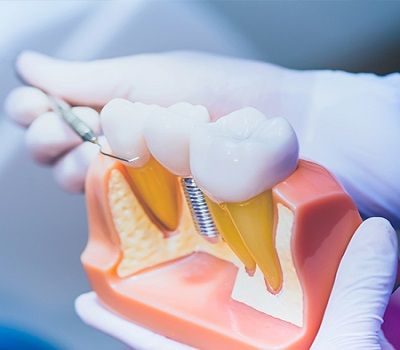Periodontal therapy in Mt Pleasant, TX
Bacteria and dental plaque cause periodontal diseases. They affect your gums and related structures. Often starting as an infection of gums (gingivitis), the diseases progress to involve alveolar bone and periodontal ligaments. If not treated on time by the skilled dentists in Mt Pleasant, TX, they can make you vulnerable to several life-threatening health issues, such as diabetes, stroke, respiratory diseases, and heart diseases. If you are experiencing symptoms like swollen or bleeding gums, pain in chewing, or persistent bad breath, you can visit us for periodontal treatment. Contact us to learn more.
Symptoms of Periodontal Diseases
- Persistent bad breath
- Swollen gums
- Bleeding from gums
- Painful chewing
- Loose teeth
- Sudden sensitivity in teeth
- Gum recession
Phases of Periodontal Treatment
Phase I: The Etiological Phase
In this phase, our Periodontist in Mount Pleasant, TX, focuses on controlling the bacterial infection and restoring the healthy microbial balance. We perform a deep oral examination to diagnose the cause of the disease. Scaling and root planing procedures are carried out to remove plaque and calculus from your teeth and gum line. Additionally, we educate you on oral hygiene and home care to maintain long-term oral health. Medicines may also be prescribed if necessary.
Phase II: The Surgical Phase
If conservative treatments fail to show the desired effects and the infection is severe, our Periodontist in Mount Pleasant, TX, will move to the surgical phase. Here, we address bone defects to remove the space between your teeth and the bone, eliminating the opportunity for bacterial invasion. This surgery is performed under anesthesia, and you can typically resume work after a day.
Phase III: The Maintenance Phase
This phase focuses on maintaining your periodontal health. As the recurrence rate of periodontal diseases can be high, our Periodontist in Mount Pleasant, TX, adopts measures to prevent their return. We provide you with a detailed guide on maintaining optimal gum health, including brushing, flossing, and using medicated mouthwash. Regular follow-ups, typically every three months, help ensure that your oral health is in good shape.
Phase IV: The Restorative Phase
Not every periodontal patient requires the restorative phase, but if you’ve undergone extensive surgery, our Periodontist in Mount Pleasant TX will plan for implants or prosthetics to replace missing teeth or large portions of tissue or bone removed during the procedure. In some cases, orthodontic treatment may be prescribed to improve teeth alignment.
In this phase, our Periodontist in Mount Pleasant, TX, focuses on controlling the bacterial infection and restoring the healthy microbial balance. We perform a deep oral examination to diagnose the cause of the disease. Scaling and root planing procedures are carried out to remove plaque and calculus from your teeth and gum line. Additionally, we educate you on oral hygiene and home care to maintain long-term oral health. Medicines may also be prescribed if necessary.
Phase II: The Surgical Phase
If conservative treatments fail to show the desired effects and the infection is severe, our Periodontist in Mount Pleasant, TX, will move to the surgical phase. Here, we address bone defects to remove the space between your teeth and the bone, eliminating the opportunity for bacterial invasion. This surgery is performed under anesthesia, and you can typically resume work after a day.
Phase III: The Maintenance Phase
This phase focuses on maintaining your periodontal health. As the recurrence rate of periodontal diseases can be high, our Periodontist in Mount Pleasant, TX, adopts measures to prevent their return. We provide you with a detailed guide on maintaining optimal gum health, including brushing, flossing, and using medicated mouthwash. Regular follow-ups, typically every three months, help ensure that your oral health is in good shape.
Phase IV: The Restorative Phase
Not every periodontal patient requires the restorative phase, but if you’ve undergone extensive surgery, our Periodontist in Mount Pleasant TX will plan for implants or prosthetics to replace missing teeth or large portions of tissue or bone removed during the procedure. In some cases, orthodontic treatment may be prescribed to improve teeth alignment.
Please reach out to Mt. Pleasant Family Dental in Mt Pleasant, TX, to have a consultation with our dentist, Dr. O. Please call us at (903) 345-6065 or schedule an online consultation, and we'll guide you further.
















